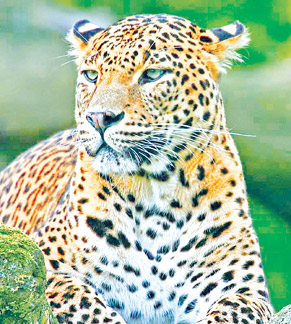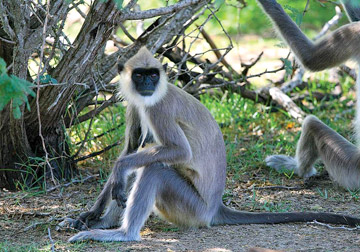Lanka’s potential for wildlife tourism
Rohantha N A Athukorala
I would do anything to watch an elephant cross the road, be it near
the ‘devala’ in Habarana, or on route to the Patanangala bungalow in
Yala or in Thekkawatte at the Udawalawe game park.
In the recent past we have seen a hype on media of the tourism
potentials which is very interesting. But a point that needs to be noted
is that this industry brings in only a 0.5 billion dollars into the
kitty of Sri Lanka whilst a less hyped industry like the IT and BPO
sector already brings in 0.45 billion dollars and will be a one billion
dollar industry by 2015.
|

The Lankan leopard |
In fact it will join the select band of one billion revenue plus
industries that Sri Lanka can show case to the world.
More importantly, what is also important to mention is that whilst
the debate on media is interesting on the many opportunities that this
industry holds good for Sri Lanka especially after the war, there are
some very basic issues that needs to be addressed before we as a nation
starts driving global trends.
To name a few are the water issue in the proposed tourism zone of
Kuchchaveli, the waste management issue in Kalpitiya, the electricity
hike that has become a policy issue for the industry that has nearly
pushed the hoteliers to go to court as well as the changing policy on
visa given that most travel agents have been contracted last year on the
terms and conditions for this years season.
Whilst we must accept that we have to be flexible to the way we do
business in Sri Lanka given that the country is just coming out of a 30
year war, we also must note that in the tourism industry business is
being contracted with overseas buyers like travel agents who dominate 70
percent plus of the global travel business.
Key question
Hence once terms and conditions are agreed it is tough to re adjust.
But I guess these are the systemic challenges that needs to be addressed
which brings the excitement in this fast track industry.
One of the key questions that needs to be focused on is, is Sri Lanka
going to drive for increasing the number of rooms or attracting a higher
end visitor to the country. The answer can be both. But, the reality is
that to construct a new property the gestation time is a minimum of
three years and at a Internal Rate of Return of around 12 to 15 percent
and pay back that can range from 8 to 10 years is a challenging decision
when the market broadly is throwing out many other growth opportunities
that are much more attractive.
|

Elephants in Minneriya |
Especially if your company is a large conglomerate operating in a
diverse product portfolio.
On the other hand if one is upgrading a property with architectural
changes that will give distinction and cut away from the competition
around the neighbourhood, the investment can be in the tune of 600 to
2000 million rupees.
This will also entail the change in shift of the demand chain that
one works in meaning travel agents and end customers who are prepared to
surrender a higher room rate for the new value proposition.
Hence we see the industry is challenged with this decision on what
the growth agenda should be for this industry whilst the day to day
volatility as mentioned above further exerts pressure on the system.
Better than competition
A point that must be noted from a demand side of the business is that
almost seventy five percent of the 14,700 hotel rooms in the country are
located in the beach belt. In my view we cannot price a room rate above
a 250 dollar threshold as a typical beach holiday seeker will compare
Sri Lanka’s proposition as against the Maldives that can offer better
beaches and an exclusive beach frontage to a typical traveller at around
450 dollars. Whilst we can argue that Sri Lanka offers more than beaches
this proposition needs to be further discussed as research has revealed
that purpose of travel by a foreigner hinges on a single minded reason
be it beaches, wildlife or culture based. Which means that strictly from
a marketing perspective, we have no option but practice the strategy
differentiated marketing. Meaning, for identified key market segments
separate business propositions.
Wildlife tourism?
This takes me to the topic of wildlife tourism and its relevance to
today’s emerging landscape of Sri Lanka.
|

A grey langur |
Wildlife tourism can be broadly defined as trips made to destinations
with the main purpose being to observe the local fauna and flora. This
can be explained as an activity of watching animals in the wild and it
covers all types of animals. Large mammals, flock of birds, all kinds of
insects and even marine life. This is essentially an observational
activity although in some countries some interactions are allowed in
control conditions.
This market is worth around a 12 million trips each year with Africa
accounting for around half of all these trips with the hot spot
destinations being Kenya, Tanzania and Botswana.My pick is Kenya for
game watching as the big five can be spotted much more easily in its
natural habitat. I guess the 500 million dollars that it contributes to
the Kenyan economy which is incidently equal to the Sri Lanka’s
contribution to in value is almost 14 percent of GDP in Kenya, which
makes the difference.
Best in class
On the other hand the Galapagos Island which rely exclusively on
wildlife tourism accounts for 60 million dollars to the nation’s
economy.
A core group of wildlife enthusiast who are working on the concept of
‘conservation tourism’ has released a set of data on the attributes of
how easy it is to actually see wildlife termed observability and time
required to sight the game. It has also looked at the what species can
be seen as charismatic like for instance the leopard or the sloth bear
that can be sited in Yala.
On this score Sri Lanka emerges as the top spot destination for Asia.
The targeted travellers essentially come from U.S, Europe mainly
Germany, UK and the Netherlands.
Whilst there is a emerging segment travelling from Canada and
Australia in the recent past.
The profile of the traveller is around 50 to 65 year age group who
have just about retired and are wealthy in nature, healthy and active
and on average spend around $475 to 1500 per day which makes this target
group attractive for the private sector of Sri Lanka Tourism to
seriously consider.
Next steps
We need to first clearly demarcate and profile the geographic
locations that offer wildlife in Sri Lanka. Udawalawa and Minneriya can
be ranked as the best places for citing the Asian Elephant whilst Yala
and Wilpattu can undoubtly ranked the best places in the world to watch
leopards.
To be honest, it cannot be even compared to the great parks of Kenya
where leopard spotting is very rare which should be the key value
proposition that can be highlighted globally. Trincomalee, Kalpitiya and
Mirissa can be highlighted for the citing of blue whale and the sperm
whale whilst Kumana is ideally situated to bird watching which is very
strong growing market globally and dominated by Bempton Cliffs in UK,
Keolandeo in India and Pantanal in Brazil.
We can also market the rainforests and bio diversity areas like
Sinharaja forest and Horton Plains that have been now declared World
Heritage sites.
We need to architecture the brand guidelines in each of these product
areas that Sri Lankan wildlife showcases. So that there is consistency
of the sub brands that emerge from each park.
Ideally only one characteristic animal species must be highlighted in
each game park so that brand positioning is easier.
This brand guideline must be then developed to a brand tool kit
template where a documentary, TV clips, brochures, pull outs are
provided by a separate unit of the Sri Lanka Tourism Ministry to the
private sector for promotional purposes. The private sector can use this
template to include one’s own lodging facility (hotel) but copied to the
regulator for reference.
This unit under Sri Lanka Tourism must architecture the code of
conduct when watching game and visiting the game parks that will include
the officials of the park, the safari vehicle drivers and owners
highlighting the principles of conservation tourism.
The lodging facilities can have the architecture of African safaris
but may be some support can be provided with certain guidelines on the
basic architecture of the hotels so that there is a central theme like
eco tourism.
There has to be monitoring and certification at periodic levels.
For instance in Kenya if a safari jeep goes off track to watch game
the fine is as high as 600 dollars and the confiscation of the driver’s
licence. This also gives exclusivity.
International media must be covered by the regulators to build this
niche market with vehicles like CNN, National Geography, Animal Planet,
Lonely Planet as well as social media like Face Book, For Squares, You
Tube, Twitter and dedicated website operated by the Ministry linking to
the lodging cites and code of conduct norms.
All national events can link to highlighting game parks for
endorsements. For instance the ICC World Cup celebrities can be used to
tour the game parks and this can be a string PR tool in markets of UK
and Australia for 2011.
Nationally dedicated travel and tourism fairs, magazines and tour
operators can be targeted that specialize in wildlife tourism.
Set a target for revenue collection from this segment at next year’s
national budget with a minimum room rate in consultation with the
private sector.
It’s important to highlight some issues as we drive for a national
strategy in this segment of business. There are issues of traffic
congestion in parks like Yala that negates the very objective of
building the business.
In Rwanda for instance visiting the mountain gorilla is limited to a
certain number of tourists per day. The overall knowledge of the guides
must be increased to international standards that follow a code of
conduct.
The facilities in the lodging houses and hotels needs to be upgraded
to the new targeted clientele that Sri Lanka can ideally attract into
Sri Lanka which will be the top end traveller.
Whilst there are some burning issues that the industry is grappling
with we need to keep in mind that as a country that is coming out of a
30 year war some systematic corrections will take place in the years to
come and we must be ready for this change.
Some can be policy led some may be adhoc operational aspects.Whilst
we go through these changes we must not lose out on the opportunities
that are emerging in the global market is my view. |



